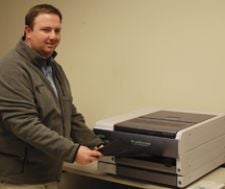
FilmStation streamlines workflow at the busy core lab.
Images come in all shapes and sizes at Bio-Imaging Technologies, which assists hundreds of companies worldwide in managing clinical trial data and bringing new drugs to market. As the world’s largest independent medical imaging core lab, Bio-Imaging receives multimodality medical images from dozens of client trial sites, analyzes data and submits it as part of the regulatory approval process to the Federal Food and Drug Administration (FDA) and other international agencies.
From chest X-rays and brain MRIs to CT scans, the lab may manage hundreds of diverse images for a single client. The new Sony FilmStation dry film imager handles them all easily, efficiently and conveniently, while delivering superior image clarity and resolution. With a large number of diverse studies from far-ranging sources, Bio-Imaging’s workflow truly tests the mettle of any printer. Over the years, using cutting-edge technology, the lab has processed more than one million images from thousands of sites worldwide. What works here is sure to pull its weight at any clinical imaging facility.
So what’s a printer doing at a business that relies heavily on digital imaging and other advanced techniques? “Film is very much an important part of the world of medicine and is not going away any time soon,” explained Jim O’Malley, director of data services for the lab. “Perhaps surprisingly, many sites participating in client studies send us hardcopy images. While study participants are asked to retain copies, not infrequently, they send us originals because they have no easy way to duplicate films.”
When Bio-Imaging receives images on film, it scans them to maintain all data in a consistent digital format. Often clients or study sites request that images be sent back, but the lab is required to retain the original images for the duration of a project. Now, with its new FilmStation imager, Bio-Imaging Technologies simply prints out a copy of the scanned films and returns them to the sender.
As an important benefit, the UPD-F550 printer’s dual-tray feature enables loading of dual film sizes simultaneously to help accommodate the wide range of images that the lab receives from sites participating in various studies. In addition to the 14-by-17-inch film size used by the original single-tray FilmStation imager, the new unit also prints 8-by-10-inch, 10-by-12-inch and 11-by-14-inch films.
“Clients are impressed that we are able to duplicate images for them in-house,” said O’Malley. “This is an extremely useful value-added service.” Prior to acquiring the FilmStation dry imager, the lab took images offsite for copying. “We had no systematic means of duplicating films. It was really quite difficult and a situation we attempted to avoid,” he said.
A bonus for Bio-Imaging is that the Sony FilmStation imager is rapidly paying for itself with the nominal fee the lab charges for image copies. According to O’Malley, within three months, the lab had already recouped half of its FilmStation purchase price, while enjoying new dividends of enhanced client satisfaction.
Before deciding on the FilmStation imager Bio-Imaging researched printers for some time. It found that the FilmStation imager delivered excellent print quality at an extremely attractive price that fit within its budget. The lab also was impressed with the printer’s features and the quality synonymous with the Sony name.
“With the dual-tray system, we do not have to waste effort re-loading the printer to handle different image sizes, or money by outputting small images on a larger-than-needed film that may already be loaded,” he said, pointing out that any multimodality clinical imaging site will derive a similar benefit.
Bio-Imaging also liked the imager’s compact footprint and unique configuration that allows both vertical and horizontal siting to accommodate a variety of needs. O’Malley notes that this is an important benefit because space is at premium in the lab, as it is at most growing companies.
At Bio-Imaging, the FilmStation imager interfaces directly with the site’s two scanners and is set up directly behind the devices. This, along with the printer’s speed of 70 14-by-17 films per hour, supports efficient workflow and helps the lab maintain control over the large volume of data that passes through the busy workplace day in and day out. “When we scan an image and print it out, we can match it right up with the original because everything is close at hand,” he said. This helps keep studies flowing smoothly through the lab.
Clinical imaging sites also have discovered that the FilmStation printer’s compact footprint and flexible set-up benefit workflow. If desired, the device can stand upright conveniently alongside a CPU or on a technologist’s desktop to eliminate time-consuming travel to and from a large central imager.
Like the original FilmStation imager, the new dual-tray model interfaces easily to any DICOM device, including PACS solutions, modalities and scanners. Automatic calibration ensures consistent image quality, while easy access to manual settings allows fine tuning. Using an innovative thermal print head, the FilmStation imager delivers high-resolution images in 4,096 shades of gray.
“Our FilmStation printer was extremely simple to set up and is user friendly,” said O’Malley. “It’s been a great addition that gets our approval for our work with the FDA.”


 December 10, 2025
December 10, 2025 









